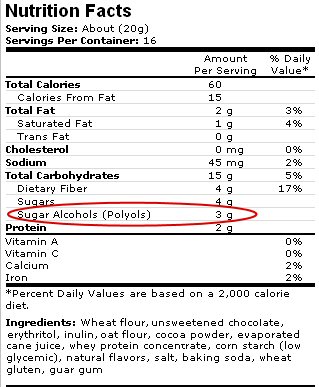Primer on Sugar Alcohols
Confused about, as a client referred them: “those sugar alcohols”? If so, check out my cut to the chase answers below:
What are Sugar Alcohols?
Sugar alcohols, also called polyols, are neither sugar or alcohol. They’re called sugar alcohols because part of their structure resembles sugar and part alcohol. Keep in mind they do contain carbohydrate.
Today polyols are in “sugar-free” foods, such as candy, cookies, ice creams and gums. They’re used alone or combined with a sugar substitute (e.g. sucralose, aspartame) to both sweeten and provide bulk (volume). (FYI: you couldn’t make a sugar-free ice cream or cookie with a sugar substitute only. The polyol provides necessary bulk.) Commonly used polyols are sorbitol, erythritol, and mannitol.
Do they raise blood glucose?
Sugar alcohols cause a lower rise in blood glucose (however, not zero rise) because they’re only partially digested and thus contain, on average, contain 2 calories per gram vs. 4 calories per gram for most other sources of carbohydrate. (Don’t forget: foods that contain sugar alcohols also contain other ingredients which may or may not contain carbohydrate. If they contain carbohydrate, they will impact blood glucose.)
However, because people most often eat foods that contains sugar alcohol on occasion vs. regularly, the American Diabetes Association notes: “there’s no evidence that the amount of sugar alcohols likely to be consumed reduce glucose, calorie intake or weight.” And it’s certainly easy for people to fool themselves because foods with sugar alcohols often brag about being “sugar-free” (see next: What’s the meaning of “sugar-free”?)
What’s the meaning of “sugar-free”?
You’ve got to understand what “sugars” means. Sugars (note the plural), per FDA, include all one unit sugars (monosaccharides, such as glucose and fructose) and two-unit sugars (disaccharrides, such as sucrose, lactose), and the commonly used sweetener high fructose corn syrup, which is roughly half glucose and fructose.
“Sugar-free” means contains no or less than 0.5 g/serving of sugars. Sugar alcohols, because they aren’t one or two unit sugars, don’t count as sugars. But that doesn’t mean they’re calorie- or carbohydrate-free!.
 What can the Nutrition Facts label reveal about sugar alcohols?
What can the Nutrition Facts label reveal about sugar alcohols?
Note that sugar alcohols are noted under the bold print and umbrella of Total carbohydrate. This means the sugar alcohols are counted within the sources of carbohydrate. If a claim such as "sugar free" is made on the label, the amount of sugar alcohols contained per serving must be shown. The specific name of the sugar alcohol may be used if the food contains only one. If more than one sugar alcohol is used, the term "sugar alcohols" must be used.
How should I count the carbohydrate from sugar alcohols?
According to recommendations from the American Diabetes Association (Choose Your Foods, 2008) in “if a food contains more than 5 grams of sugar alcohols per serving (meaning less than 5 grams result in negligible carbs and calories) subtract half the grams of sugar alcohol from the Total carbohydrate grams to get your grams of carbohydrate per serving. (Ex: a food contains 16 grams of sugar alcohols, count 8 grams in your total carb count.) Why? Because sugar alcohols contain 2 vs. 4 calories per gram).
Learn more:
Check out Calorie Control Council’s - a trade association for the sugar alcohol industry and my book Diabetes Meal Planning Made Easy.

